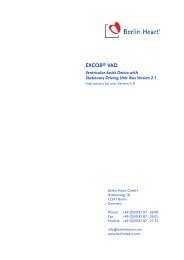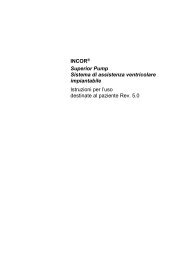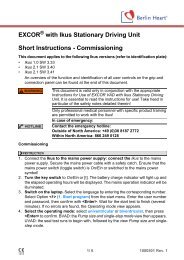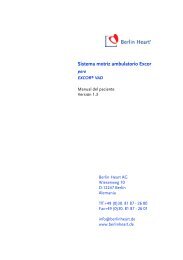Instructions for use: Ikus - Berlin Heart
Instructions for use: Ikus - Berlin Heart
Instructions for use: Ikus - Berlin Heart
Create successful ePaper yourself
Turn your PDF publications into a flip-book with our unique Google optimized e-Paper software.
9.5.1 Visual inspection: Filling/ ejecting of the blood pump<br />
Regular inspection of blood pump(s) and cannulas<br />
A blood pump fills and empties optimally if, in the end-of-systole and end-of-diastole<br />
positions, the membrane surface is completely smooth. Check over several pump cycles<br />
that the pump(s) is/are filling and emptying completely. If a pump does not fill and/or<br />
empty completely, then corresponding corrective action must be taken.<br />
Corrective action<br />
• For each blood pump: Check the position and condition of the driving tube and cannulas.<br />
(Inflow deterioration due to breaking off of the cannulas/driving tubes is rather<br />
uncommon.)<br />
• For each blood pump: Check the membrane movement.<br />
• Medicinal monitoring of the patient: Check CVP; check mean arterial pressure and adjust<br />
if necessary.<br />
• Check volume situation:<br />
• Quantity of bleeding<br />
• Increased elimination (diuretics?)<br />
• Tamponade<br />
• Important: Increasing the negative pressure cannot ca<strong>use</strong> any major<br />
improvement if a corresponding volume supply is not available.<br />
• For LVAD: Pay attention to the right heart function.<br />
Adjusting the parameter values<br />
Only adjust the parameters if the above-mentioned corrective action has no effect or <strong>for</strong><br />
• Mobilization of patient: Adjustment of the left and right systolic pressure. Do not reduce<br />
pressures which have been increased while the patient is lying down.<br />
• Signs of cardiac insufficiency: With good membrane movement, a decline in urine<br />
elimination, lactate increase and shortness of breath must be observed. In this case,<br />
increase the rate and adjust other settings. If necessary, consider replacing the pump<br />
(larger volume).<br />
<strong>Instructions</strong><br />
1. Move the cursor with ← / → to the desired field in the parameter table. The active field<br />
is colored underneath.<br />
2. Adjust the value with ↓,↑/ / , then confirm with . The system<br />
works with the new value.<br />
Cautionary measure<br />
• Confirm each changed parameter value individually with . The system only<br />
applies the changed values after this confirmation.<br />
9.5.2 Visual inspection: Deposits<br />
At least three times per day, check the blood pump(s) <strong>for</strong> deposits (fibrin, thrombi).<br />
Record any findings in the “EXCOR Pump Log” (standard <strong>for</strong>m see page 94). If deposits<br />
are beginning: Check the anticoagulation therapy!<br />
1000002 Rev. 4.9.1 59







